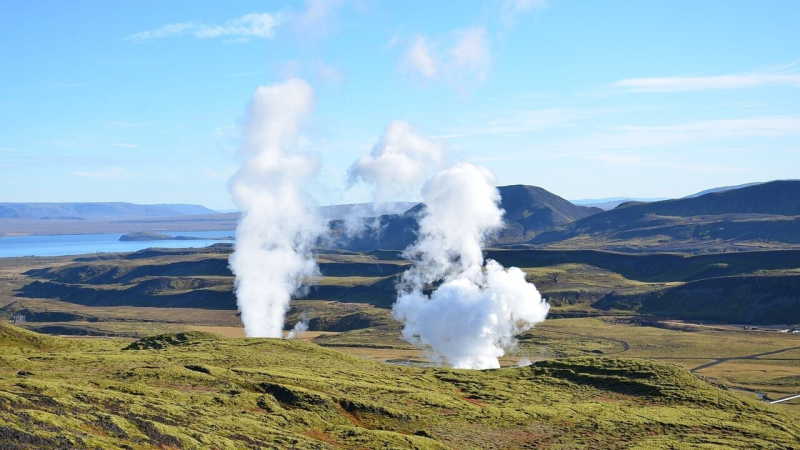Europe plots to replace natural gas with geothermal energy
By: Ioanna Lykiardopoulou (TNW Tech)


A range of European governments have developed plans to harness geothermal energy — and end their reliance on Russian gas

Putin thought the EU would cave to his threats about military action. The result is massive arms shipments to Ukraine.
Putin thought the EU would cave to high LNG prices. The result is that the EU is no longer buying Russian gas.
O-o-o-o-p-s....


Their motivations are clear: geothermal energy is 100% renewable, endless, and reliable. And the attraction has only intensified amid the drive to reduce dependence on Russian natural gas.
Currently, Germany is leading the transition. At the end of 2022, the country's government published a plan targeting a tenfold increase in geothermal output: 10TWh by 2030.
"We're sitting on a gold mine," Christian Peltl, director of geothermal energy at SWR, the operator of a geothermal plant in Munich, told AFP. "There was really a boom in orders since the beginning of the [energy] crisis," he added.
Meanwhile, the French government recently announced an action plan for the development of surface and deep geothermal energy. The goal is to produce enough geothermal heat in 15 to 20 years to save annually 100TWh of gas and achieve carbon neutrality by 2050. In 2021, geothermal energy accounted for only 1% of the country's final heat consumption, which translates to approximately 6TWh.
Similarly, the Italian government is discussing how to support the expansion of geothermal energy, while Hungary aims to upscale production of geothermal energy and subsequently replace about 1-1.5 billion cubic metres of natural gas per year. And Europe's largest geothermal heating plant, in the city of Aarhus in Denmark, is expected to be completed by 2030, with the capacity to cover 30% of the district's energy needs.
According to EU data, replacing fossil fuels with geothermal energy could decarbonise up to 25% of the bloc's population energy needs, while also reducing bills. Geothermal plants could also supply up to 10% of Europe's power demand. And it seems that the renewable resource is finally getting the necessary traction to boost the continent's energy independence and help meet its climate targets.
Germany's target of 10 TWh of geothermal output from medium-depth and deep resources is an ambitious one. To realise the goal, the country aims to add at least 100 additional geothermal projects by 2030. These would connect to the heating grid and supply energy to residential buildings and industrial companies.
Story by Ioanna Lykiardopoulou. Ioanna is a writer at SHIFT. She likes the transition from old to modern, and she's all about shifting perspectives. Ioanna is a writer at SHIFT. She likes the transition from old to modern, and she's all about shifting perspectives.






The most important producer of geothermal energy is... the United States. This is from the Park Service
Geothermal Potential
Geothermal energy is a type of heat energy generated and stored within the Earth. The energy is clean, renewable, and provides energy in the United States and around the world for electricity and other uses. Resources of geothermal energy range from hot water and hot rock found a few miles beneath the Earth’s surface and even deeper to extremely high temperatures of rock called magma. The hot water near the surface of the Earth can be used to:
One of the biggest advantages of geothermal energy is that it is constantly and consistently available. The continuous flow of heat from the Earth ensures an unlimited supply of energy for billions of years.
Geothermal Electricity
Wells drilled around one mile deep into underground reservoirs can tap steam and very hot water that drives turbines linked to generators and produces geothermal-generated electricity. The reservoirs are deep underground and undetectable above ground. Geothermal energy finds its way to the Earth’s surface in three ways:
Geothermal Energy in the U.S.
The United States is the world’s largest producer of geothermal energy. Today, most geothermal energy is produced in four states:
The largest geothermal development is The Geysers north of San Francisco, California . Geothermal development on federal land requires studies to determine what effect a geothermal plant may have on the environment. For example, the geysers and fumaroles in Yellowstone and Lassen Volcanic National Parks, Valles Caldera National Preserve, Crater Lake National Park and Hawai’i Volcanoes are protected from geothermal plants because of the negative impact they would have on the area. Although some areas are protected, here are some exceptions:
The advantages of geothermal energy are:
A friend of mine a few years back was in construction installing caissons and came up with a coil type device that could be inserted into the caissons. He took the idea to Sacramento to apply for a grant but got nowhere with it.
What sort of caisson?
Structural, within foundations for homes, schools, etc.
Most construction near the coast requires caissons.
The coil device was some sort of heat exchanger?
Yes. He had a great design (as far as I could tell).
He was ahead of his time. Nowadays, heat exchangers are "in".
When I lived in Nevada I found out about the amount of geothermal energy that could be produced just by Nevada.
There are 26 plants currently in Nevada.
It looks like Europe will be increasing its take of geothermal energy to the detriment of Russia, which is a very good thing.
Everyone wondered at the EU accepting such a Russian Trojan Horse. Apparently there was a Plan B.
It is sad though that this is what it took for them to move to Geothermal. They should have been moving in this direction to begin with.
True. But let's not kid ourselves: Big Oil is just as powerful in the EU as in the US.
Sad but true.
Morning..
They need to look at New Zealand first..
There are majour problems over there because so many people have tapped into it...
Geothermal is not an unlimited supply as New Zealand has found out.
Interesting!
I can't find anything on that, Shona. Do you have a link?
The one drawback to geothermal energy is that it is location specific.
Morning..
When talking to my friends over there she use to live in Rotorua..over the years a lot of the geysers, hot springs and mud pools have disappeared...
The main reason they said were the power plants and people privately drilling down to get the geothermal...plus there was a mention of arsenic in the environment becoming more prevalent in some areas where they located power plants etc..
And over time the continual use of geothermal can cause the land to sink etc in these areas..not to mention the smell..🤮
Thanks for the information.
Like so many things today, people tend to jump before they think. Geothermal is a great option but it will not replace fossil fuels or other clean energy alternatives. We need a comprehensive approach to energy production that doesn’t completely exclude any resource.
My biggest issue with Geothermal is all the drilling that is involved. Significantly increases potential for groundwater contamination.